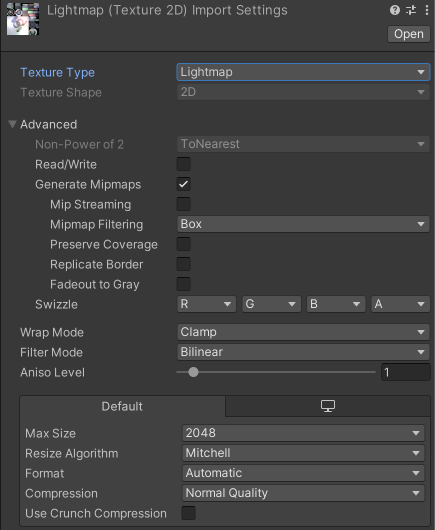- Unity User Manual 2022.1
- グラフィックス
- テクスチャ
- テクスチャのインポート
- テクスチャのインポート設定
- Shadowmask
Shadowmask
Texture Type (テクスチャタイプ) を Shadowmask にすると、テクスチャアセットが、シャドウマスク として使用するのに適した形式になります。このテクスチャタイプの Texture Shape は、Unity によって 2D に固定されます。詳細は Texture Shape を参照してください。
プロパティ

| Property | Description | |
|---|---|---|
| Non Power of 2 | Specifies how Unity scales the dimension size if the texture source file has a non-power of two (NPOT) dimension size. For more information on NPOT dimension sizes, see Importing Texture. | |
| None | Texture dimension size stays the same. | |
| To nearest | Scales the Texture to the nearest power-of-two dimension size at import time. For example, a 257x511 px Texture is scaled to 256x512 px. Note that PVRTC formats require Textures to be square (that is width equal to height), so the final dimension size is upscaled to 512x512 px. | |
| To larger | Scales the Texture to the power-of-two dimension size of the largest dimension size value at import time. For example, a 257x511 px Texture is scaled to 512x512 px. | |
| To smaller | Scales the Texture to the power-of-two dimension size of the smallest dimension size value at import time. For example, a 257x511 px Texture is scaled to 256x256 px. | |
| Read/Write | Indicates whether to access the texture data from scripts using Texture2D.SetPixels, Texture2D.GetPixels and other Texture2D methods. Internally, Unity uses a copy of the Texture data for script access, which doubles the amount of memory required for the Texture. This property is therefore disabled by default, and you should enable it only if you require script access. For more information, see Texture2D. | |
| Generate Mipmaps | Indicates whether to generate mipmaps for this texture. | |
| Mip Streaming | Indicates whether to use Mipmap Streaming for this texture. This property is only visible when you enable Generate Mipmaps. |
|
| Mip Map Priority | The priority of the textures in the Mipmap Streaming system. Unity uses this setting in two ways: * To determine which textures to prioritize when assigning resources. * As a mip bias value when choosing a mip level that fits in the memory budget. For example, with a priority of 2, the mipmap streaming system tries to use a mipmap two mip levels higher than Textures with a priority of 0. Positive numbers give higher priority. Valid values range from –128 to 127. |
|
| Mipmap Filtering | Specifies the method Unity uses to filter mipmaps and optimize image quality. This property is only visible when you enable Generate Mipmaps. |
|
| Box | Makes mip levels smoother as they decrease in dimension size. | |
| Kaiser | Runs a sharpening algorithm on mipmaps as they decrease in dimension size. Use this option if your textures are too blurry when far away. The algorithm is of the Kaiser Window type. For more information, see Wikipedia. |
|
| Preserve Coverage | Indicates whether the alpha channel in generated mipmaps preserves coverage during the alpha text. For more information, see TextureImporterSettings.mipMapsPreserveCoverage. This property is only visible when you enable Generate Mipmaps. |
|
| Alpha Cutoff | The reference value that controls the mipmap coverage during the alpha test. This property is only visible when you enable Preserve Coverage. |
|
| Replicate Border | Indicates whether to stop colors bleeding out to the edge of the lower MIP levels. This is useful for light cookies. This property is only visible when you enable Generate Mipmaps. |
|
| Fadeout to Gray | Indicates whether mipmaps should fade to gray as the mip levels progress. This is useful for detail maps. The left-most scroll is the first mip level to begin fading out. The right-most scroll defines the mip level where the texture is completely grayed out. This property is only visible when you enable Generate Mipmaps. |
|
| Ignore PNG Gamma | Indicates whether to ignore the gamma attribute in PNG files. This option is only visible if the texture source file is a PNG. | |
| Swizzle | Specifies how to order the texture source file color channel data. | |
| Wrap Mode | Specifies how the texture behaves when it tiles. | |
| Repeat | Repeats the texture in tiles. | |
| Clamp | Stretches the texture’s edges. | |
| Mirror | Mirrors the texture at every integer boundary to create a repeating pattern. | |
| Mirror Once | Mirrors the texture once, then clamps it to edge pixels. Note: Some mobile devices don’t support Mirror Once. In this case, Unity uses Mirror instead. |
|
| Per-axis | Provides options you can use to individually control how Unity wraps textures on the U and V axis. | |
| Filter Mode | Specifies how Unity filters the texture when the texture stretches during 3D transformations. | |
| Point (no filter) | The texture appears blocky up close. | |
| Bilinear | The texture appears blurry up close. | |
| Trilinear | Like Bilinear, but the texture also blurs between the different MIP levels. | |
| Aniso Level | Controls the texture quality when you view the texture at a steep angle. Anisotropic filtering is good for floor and ground Textures but is resource intensive. For more information, see Importing textures. | |
In addition, you can use the Platform-specific overrides panel to set default options and overrides for specific platforms.
Copyright © 2023 Unity Technologies. Publication 2022.1